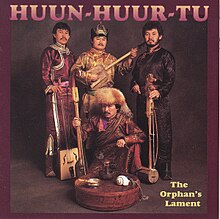| The Orphan's Lament | ||||
|---|---|---|---|---|
 | ||||
| Studio album by Huun-Huur-Tu | ||||
| Released | 1994 | |||
| Genre | Tuvan throat singing | |||
| Label | Shanachie | |||
| Producer | Alexander Bapa | |||
| Huun-Huur-Tu chronology | ||||
| ||||
The Orphan's Lament is an album by the Tuvan musical group Huun-Huur-Tu. It was released in 1994. The group supported the album with a North American tour.
Production
Recorded in New York and Moscow, the album was produced by Alexander Bapa, who also played percussion. Anatoli Kuular joined the group after the departure of Albert Kuvezin. The group used a doshpuluur as well as a dazhaanning khavy, a percussive instrument crafted from a bull scrotum.
Critical reception
| Review scores | |
|---|---|
| Source | Rating |
| AllMusic | |
| Entertainment Weekly | A− |
| MusicHound World: The Essential Album Guide | |
Entertainment Weekly praised the "rich, piercingly evocative musical universe." The New York Times wrote that "the group has met Western listeners partway, keeping songs short and varied; some sound like Appalachian rural tunes from half a world away." The San Diego Union-Tribune noted that "the vocal intensity has been toned down in places and there is a greater emphasis on lilting instrumental work." The Record stated that "there are subtle rhythmic patterns and even subtler musical textures that imitate the sound of creatures and the wind of the Siberian plains."
AllMusic wrote: "Not content to blindly follow traditional Central Asian folk music, Huun Huur Tu's four, sometimes five, performers create an ensemble that offers a complex, fascinating, and harmonious mixture." The album was included in 1,000 Recordings to Hear Before You Die. In 2003, The Independent listed it among the 50 essential "world music" albums.
Track listing
| No. | Title | Length |
|---|---|---|
| 1. | "Prayer" | |
| 2. | "Ancestors" | |
| 3. | "Aa-Shuu Dekei-Oo" | |
| 4. | "Eerbek-Aksy" | |
| 5. | "The Orphan's Lament" | |
| 6. | "Kaldak Khamar" | |
| 7. | "Steppe" | |
| 8. | "Borbanngadyr" | |
| 9. | "Chiraa-Khoor ('The Yellow Trotter')" | |
| 10. | "Exile's Song" | |
| 11. | "Eki Attar" | |
| 12. | "Irik Chuduk ('The Rotting Log')" | |
| 13. | "Sygyt" | |
| 14. | "Agitator" | |
| 15. | "Khomuz Medley" | |
| 16. | "Ödugen Taiga" |
References
- Point, Michael (14 Feb 1995). "Singers build bridge from Tuva to Texas". Austin American-Statesman. p. E7.
- Danielson, Virginia; Reynolds, Dwight; Marcus, Scott (September 25, 2017). The Garland Encyclopedia of World Music: The Middle East. Routledge.
- Suzuki, Dean (Jun 1995). "Street cred — The Orphan's Lament by Huun-Huur-Tu". Wired. Vol. 3, no. 6. p. 182.
- Livingstone, William (Jun 1995). "Quick fixes — The Orphan's Lament by Huun-Huur Tu". Stereo Review. Vol. 60, no. 6. p. 88.
- Broughton, Simon; Ellingham, Mark; Trillo, Richard; Duane, Orla; McConnachie, James (August 10, 2000). World Music: Latin and North America, Caribbean, India, Asia and Pacific. Rough Guides.
- "Throat Singers of Tuva". The Milwaukee Journal. 6 Jan 1995. p. 15E.
- Warshall, Peter (Summer 1997). "Tuvinian Singers & Musicians". Whole Earth. No. 90. p. 94.
- ^ MusicHound World: The Essential Album Guide. Visible Ink Press. 2000. p. 332.
- Bender, Sarah C. (January 26, 1995). "Mongolian Band a Hit on Campuses". Journal Star. Peoria. p. C4.
- "Huun-Huur-Tu Biography, Songs, & Albums". AllMusic.
- ^ Porter, Mark (February 17, 1995). "Siberia's Throaty Songsters". Lifestyle/Previews. The Record. Hackensack. p. 7.
- Condon, Garret (19 Jan 1995). "The Orphan's Lament Huun Huur Tu". Calendar. Hartford Courant. p. 5.
- ^ "Huun-Huur-Tu The Orphan's Lament". AllMusic.
- ^ "The Orphan's Lament". Entertainment Weekly.
- Pareles, Jon (21 Feb 1995). "Strange Asian Sounds That Defy Western Notation". The New York Times. p. C14.
- Varga, George (February 2, 1995). "The Orphan's Lament Huun-Huur-Tu". Entertainment. The San Diego Union-Tribune. p. 10.
- Moon, Tom (August 28, 2008). 1,000 Recordings to Hear Before You Die: A Listener's Life List. Workman Publishing.
- Church, Michael (27 June 2003). "World Music: On top of the world". Features. The Independent. pp. 20, 21.